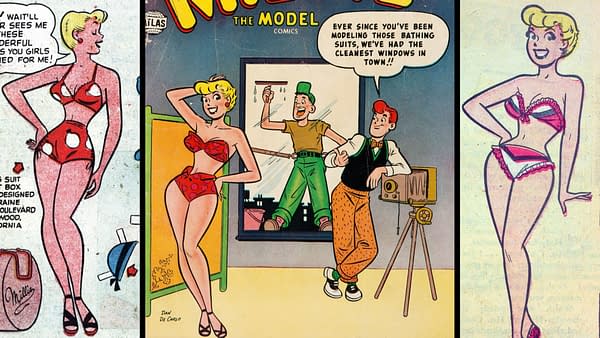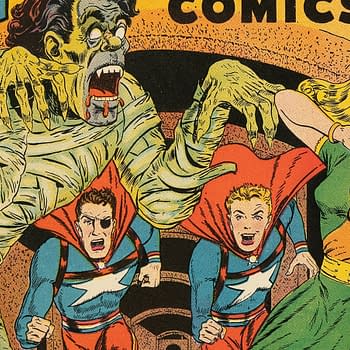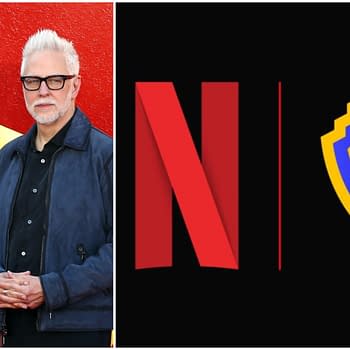Posted in: Comics, Heritage Sponsored, Vintage Paper | Tagged: Dan DeCarlo, millie the model
Dan DeCarlo and the Evolution of Millie the Model, Up for Auction
As Millie the Model Comics progressed through the 1950s, Dan DeCarlo's approach transformed the title, which eventually rebooted Millie's origin twice.
Article Summary
- Dan DeCarlo's arrival at issue #18 revamped Millie with humor and style.
- Millie's origin was treated as more of a serious drama in issue #1.
- Reader engagement with fashion ideas influenced the content of the series.
- Millie's backstory was rebooted twice to align with series relaunches.
Millie Collins, better known as Millie the Model, was the creation of writer-artist Ruth Atkinson, who wrote and drew most of the stories in Millie the Model Comics #1. Atkinson had previously co-created Patsy Walker at Marvel, and also did significant work for Fiction House. Atkinson portrayed Millie's story as the drama of a career-oriented working girl trying to make it in New York City. That debut issue had a significantly more serious tone than what was to follow. Artist-writer Ken Bald took over with issue #2, and the series immediately became more of a light-hearted situation comedy. The title would continue to lean into situation comedy until being transformed again by the arrival of Dan DeCarlo with issue #18. DeCarlo's distinctly expressive style and gift for visual comedy would drive Millie's adventures into a continuing series of humorous gags held together by his ability to add drama, emotion and even allure to the story with an approach that in later years would help define the look of Archie Comics.

Millie's origin story as created by Atkinson for Millie the Model Comics #1 was actually played as something of a tragedy at its start. Millie won a beauty pageant in the town of Barberton, which resulted in a picture of her wearing a bathing suit appearing in the local paper. Her strict parents were so scandalized by this that they essentially kicked her out of the house because of concerns over how this would affect their reputation in the community. She decided to go to New York City with her friend Marge to try to make it as a model there, overcoming numerous obstacles to eventually land at the Hanover Modeling Agency.
This rather serious beginning is at odds with the rest of the series, but since it became a gag-driven comedy without much issue-to-issue continuity, that never really mattered. However, perhaps inspired by the example of Bill Wogon's Katy Keene, Millie the Model Comics began to encourage readers to send in fashion ideas for the characters beginning in issue #29, and this seems to have led later-years readers to write in asking about how Millie got her start.
Issue #91 (cover-dated July 1959) kicks off How Millie Became a Model, a two-part story by DeCarlo and Stan Lee that spans two issues. With the title page blurb explaining that this tale is in response to reader demand, it's a complete departure from Atkinson's serious issue #1 origin tale. Millie and her family are now residents of Sleepy Gap, Kansas. In a setup that seems generally inspired by Al Capp's Li'l Abner, her family is stereotypically portrayed rural hillbillies living in a log cabin. Millie is an outcast among her family, because although she is as beautiful as she's been since issue #1, she is not a "healthy-looking farm girl" by her family's standards. Frustrated by what they see as her useless nature in this environment, they send her off to the big city to attempt to find her fortune, fully expecting her to fail and "come back plump and pretty" and ready to embrace the farm life.
Once in New York City, she's treated like a star everywhere she goes because in this place, people recognize that she is pretty enough to be a model. Interestingly, she makes her way to the Hanover Model Agency just as Hanover's star model Chili is demanding a raise. Millie is hired on the spot, setting off the Millie/Chili rivalry from the jump. This point is also a notable departure from the earlier issues, as Chili was originally introduced in issue #3, after Millie had established herself at Hanover. The new origin also corresponds with the relaunch of A Date With Millie, a revival of the short-lived 1956 series of the same name. There's also some indication that the backstory was meant to cast Millie as simple and naive in contrast with Chili's cool sophistication.
Whatever the plan was there, it would be short-lived. Millie's origin was again revised a short time after issue #92 with issue #100's How Millie First Met Chili, which seems to abandon the rural Kansas backstory and has Millie working in NYC as a typist who is sent to Hanover Model Agency to work in that capacity. But as with the #91-92 revision, she's hired as a model on the spot as a hedge against' Chili's demands for a raise. And as we saw with that previous revision, Millie the Model Comics #100's origin retold moment was a promotion of sorts for the launch of Life with Millie. which itself took the place of the short-lived second attempt at A Date With Millie, continuing the numbering of that series.
Five years later, Millie made a quiet entry into the Marvel Universe with her appearance in Fantastic Four Annual #3. and her original series ran for an impressive 207 issues until its final release in December 1973. There are a number of early issues of Millie the Model Comics from throughout the 1950s up for auction with Millie the Model Group of 13 (Timely/Atlas, 1949-59) Condition: Average GD/VG in the 2024 June 30-July 2 Sunday, Monday & Tuesday Comic Books Select Auction #122427 at Heritage Auctions.
















